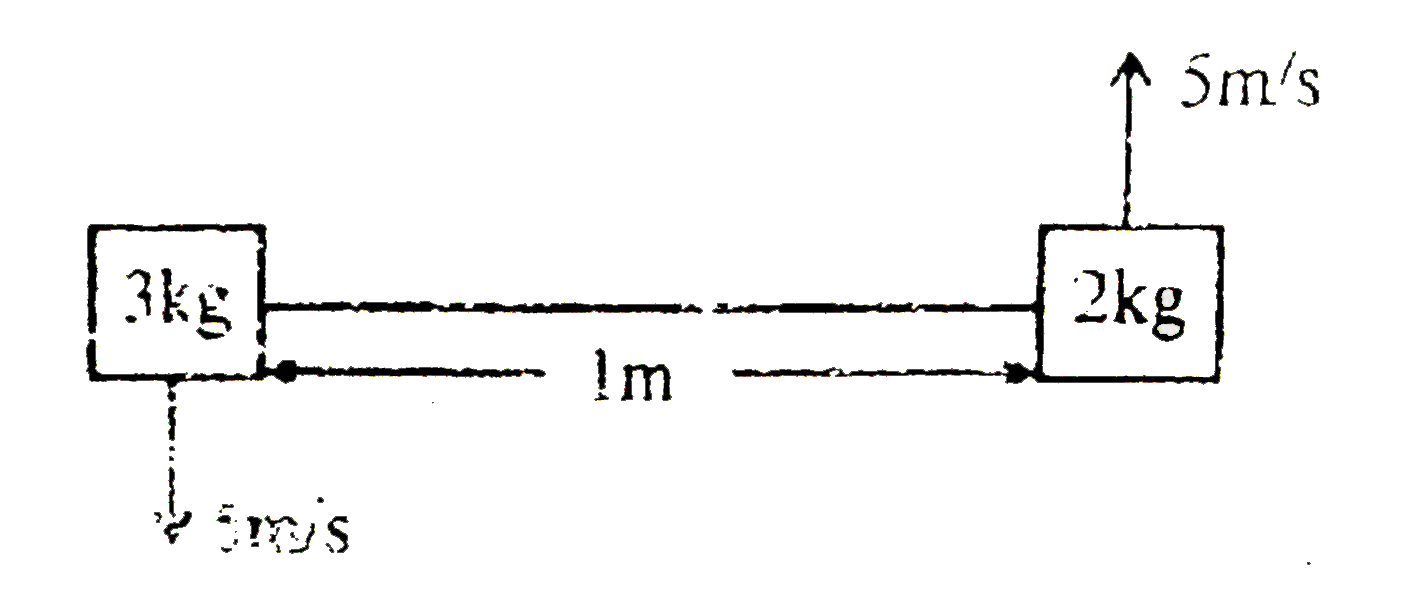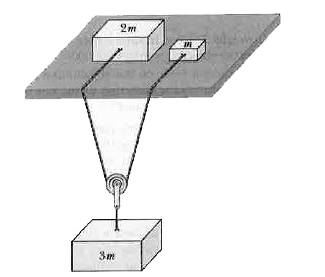A particle A of mass 2 kg lies on the edge of a table of height 1m. It is connected by a light inelastic string of length 0.7 m to a second particle B of mass 3 kg which is lying on the table 0.25 m from the edge (line joining A & B is perpendicular to the edge). If A is pushed gently so that it start falling from table then, find the speed of B when it starts to move. Also find the imulsive tension in the string at that moment.
The correct Answer is:1.2 m/s, 3.6 Ns
Step by step video, text & image solution for A particle A of mass 2 kg lies on the edge of a table of height 1m. It is connected by a light inelastic string of length 0.7 m to a second particle B of mass 3 kg which is lying on the table 0.25 m from the edge (line joining A & B is perpendicular to the edge). If A is pushed gently so that it start falling from table then, find the speed of B when it starts to move. Also find the imulsive tension in the string at that moment. by Physics experts to help you in doubts & scoring excellent marks in Class 12 exams.
Topper's Solved these Questions
- BOOK - MOTIONCHAPTER - CENTRE OF MASSEXERCISE - Exercise - 4 Level-I18videos
CENTRE OF MASS
- BOOK - MOTIONCHAPTER - CENTRE OF MASSEXERCISE - Exercise - 4 Level-II20videos
CENTRE OF MASS
- BOOK - MOTIONCHAPTER - CENTRE OF MASSEXERCISE - Exercise - 3 Level-I34videos
CENTRE OF MASS
- BOOK - MOTIONCHAPTER - Capacitance EXERCISE - EXERCISE -4 LEVEL II19videos
Capacitance
- BOOK - MOTIONCHAPTER - CIRCULAR MOTIONEXERCISE - EXERCISE - 416videos
CIRCULAR MOTION
Similar Questions
A particle A of mass 2m is held on a smooth horizontal table and is attached to one end of an inelastic string which runs over a smooth light pulley at the edge of the table. At the other end of the string there hangs another particle B of mass m, the distance from A to the pulley is l. The particle A is then projected towards the pulley with velocity u.

(a) Find the time before the string becomes taut, and shown that after the string becomes taut, the initial velocity of A and B is 4u/3.
(b) Find the common velocity when A reaches the pulley (assume that B has not yet reached the ground).View SolutionA chain of linear density 3 kg /m and length 8 m is lying on the table with 4 m of chain hanging from the edge. The work done in lifting the chain on the table will be -
View Solution
Knowledge Check
- Question 1 - Select One
Two block of masses 2kg and 3kg are connected by string of length 1m. At any instant the velocitities of block of mass 2kg and 3kg is 5m/s in opposite direction and perpendicular to the length of string and is also parallel to horizontal table.
 Atension in the string is 110NBtension in the string is 120NCtension in string is 75NDtension in string is 50N
Atension in the string is 110NBtension in the string is 120NCtension in string is 75NDtension in string is 50N - Question 2 - Select One or More
A uniform chain of length L lies on a smooth horizontal table with its length perpendicular to the edge of the table and a small portion of the chain is hanging over the edge. The chain starts sliding due to the weight of the hanging part
AThe acceleration of the chain is (gx/L), where x is the length of the hanging part of chain.BThe acceleration of the chain is (g/L)(L−x), where x is the length of hanging part of chain.CThe velocity of the chain is x√gL, where x is the length of hanging part of chain.DThe velocity of the chain is (L−x)√gL, where x is the length of hanging part of chain. - Question 3 - Select One
Four particles of masses 1kg, 2kg, 3kg and 4kg are placed at the four vertices A, B, C and D of a square of side 1m. Find the position of centre of mass of the particles.
A(0.5,0.3)B(0.4,0.3)C(0.5,0.8)D(0.7,0.3)
Two particles A and B of mass 2m and m respectively are attached to the ends of a light inextensible string of length 4a which passes over a small smooth peg at a height 3a from an inelastic table. The system is released from rest with each particle at a height a from the table. Find -
(i) The speed of B when A strikes the table
(ii) The time that elapses begore A first hits the table.
(iii) The time for which A is resting on the table after the first collision & begore it is first jerked off.View SolutionTwo particles (A and B) of masses m and 2m are joined by a light rigid rod of length L. The system lies on a smooth horizontal table. The particle (A) of mass m is given a sharp impulse so that it acquires a velocity u perpendicular to the rod. Calculate maximum speed of particle B during subsequent motion. By what angle θ will the rod rotate by the time the speed of particle B become maximum for the first time ?
 View Solution
View SolutionTwo balls of masses m1=5kg,m2=10kg are connected by a light inextensible string. A horizontal force F = 15 N is acting on the ball m2 along the line joining two balls as shown. What is the (a) acceleration of the balls (b) tension in the string?
 View Solution
View SolutionTwo particles of masses m and 2m are placed on a smooth horizonttal table. A string, which joins these two masses, hangs over the edge supporting a pulley, which suspends a particle of mass 3m, as shown in Fig. 5-40. The pulley has negligible mass. The two parts of the string on the table are parallel and perpendicular to the edge of the table. The hanging parts of the string are vertical. Find the acceleration of the particle of mass 3m.
 View Solution
View SolutionA block A of mass m1 rests on a horizontal table. A light string connected to it passes over a frictionless pully at the edge of the table and from its other end another block B of mass m2 is suspended. The coefficient of kinetic friction between the block and the table is H. When the block A is sliding on the table, the tension in the string is
View Solution
